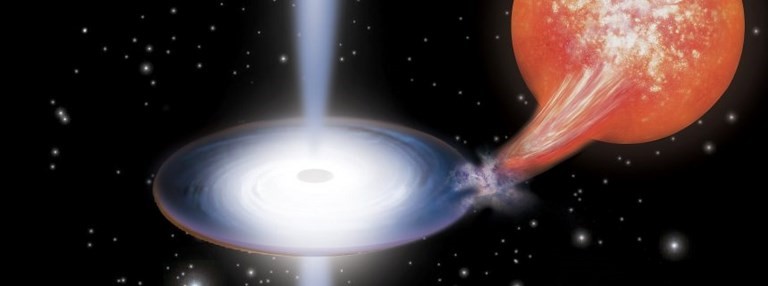Black Holes Throwing Iron into Space
Black Holes are firing mysterious jets into space. Astronomers have recently witnessed an eruption. They think that hey have recognized the nature of the expulsed matter.

DPA/ Nature/ Riccardo Lanfranchi
Black holes swallow any kind of matter getting close to them. Yet, as a rule, before being irretrievably sucked up, it assembles to form a fast rotating disk. In many black holes though, powerful rays of matter, so-called jets, shoot out of these accretion disks, perpendicularly, from “top” and “bottom,” into space. Astronomers have discovered that these fountains of matter are made up of iron and of nickel.
“Despite the fact that they have observed for decades, we are still not sure about what they are made of, and about what triggers them,” explains María Díaz Trigo from the European Southern Observatory (ESO) in a communication from ICRAR, the International Center for Radio-Astronomy Research, in Australia. Using ICRAR’s instruments and the European X-Ray satellite XMM-Newton researchers have recently witnessed how, out a newly discovered black hole, a jet suddenly appeared.
Where does the positive charge come from?
"We have long known that the jets contain electrons, yet they do not actually have a negative electrical charge, therefore there must something inside them that is positively charged,“ explained her co-author, James Miller Jones of ICRAR. "Until now, it wasn’t clear, whether the positive charge was coming from positrons, the anti-matter opposites of electrons, or from positively charged atoms."
Analysis of the jets‘ radiation has now produced characteristic spectrum lines, the unmistable fingerprints of atoms of iron and nickel. The researchs explain in the magazine Science that a considerable amount of the jets is made up of atoms of various elements. Atoms being much heavier than positrons, the jets are able to carry much more energy out of the system than would rays made up of electrons and positrons.
Measurements make it also possible to detect the speed oft the jets coming out of the observed black hole: they shoot into space at a speed of a full 200,000 kilometers per second, that is two thirds of the speed of light. The jets are propulsed by the fast rotating accretion disk, and not by the Black Hole itself.
Axel Bojanowski
Translated by Anne-Marie de Grazia
From Der Spiegel , Nov. 14, 2013
Top of page

